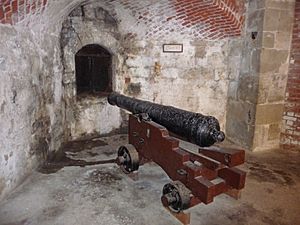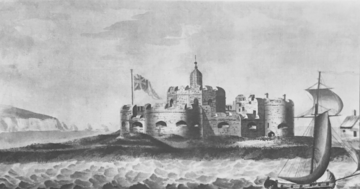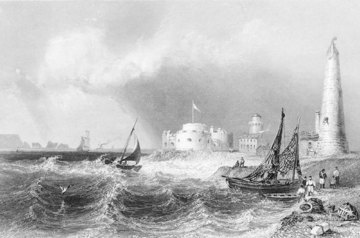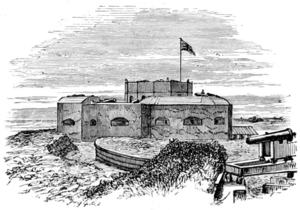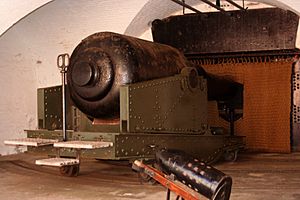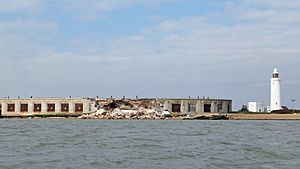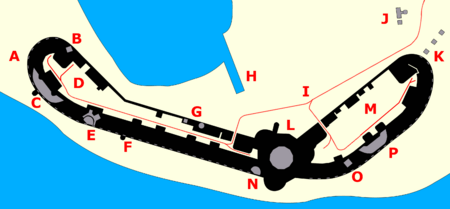Hurst Castle facts for kids
Quick facts for kids Hurst Castle |
|
|---|---|
| Hurst Point, Milford on Sea, Hampshire, England | |
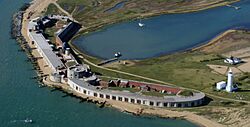
The castle seen from the south-east in 2011
|
|
| Coordinates | 50°42′23″N 1°33′04″W / 50.70639°N 1.55111°W |
| Type | Device Fort |
| Site information | |
| Owner | English Heritage |
| Open to the public |
Yes |
| Official name | Hurst Castle and lighthouse |
| Designated | 9 October 1981 |
| Reference no. | 1015699 |
| Condition | Intact |
| Site history | |
| Built | 1541–44; 1861–74 |
| In use | 1544-1945 |
| Materials | Stone, Brick |
Hurst Castle is an old fort built by King Henry VIII between 1541 and 1544. It stands on the Hurst Spit in Hampshire, England. The king built it as part of his plan to protect England's coast from invaders from France and the Holy Roman Empire. The castle guarded the western entrance to the Solent, a waterway leading to important naval bases.
The first castle had a central tower and three strong points called bastions. By 1547, it had 26 guns. It was a very powerful fort, but also expensive to run. During the English Civil War in the 1640s, the castle was held by Parliament's forces. King Charles I was even held there briefly before he was executed in 1649.
The castle was used for many years, but it started to fall apart in the 18th century. Smugglers often used the nearby spit. During the wars with France in the late 1700s and early 1800s, the castle was repaired and updated. It was made ready to hold bigger guns.
New fears of invasion in the 1850s led to even heavier guns being added. New gun batteries were built on both sides of the old castle. But technology changed quickly, making these defenses old-fashioned. So, between 1861 and 1874, a huge new project created 61 gun positions. These were in two long, granite-faced batteries next to the older castle. They held massive weapons, including very heavy rifled muzzle-loading guns. Later, lighter, quick-firing guns were added.
Hurst Castle was part of the Solent's defenses during the First World War and was re-armed again in the Second World War. The military stopped using the fort in 1956. Today, English Heritage and the Friends of Hurst Castle manage it as a popular tourist spot. About 40,000 people visited in 2015. However, Coastal erosion is a growing problem, threatening the castle. Four lighthouses have been built at Hurst since the 1700s, and one of them, built in 1867, is still working today.
In February 2021, part of the eastern wall of the castle collapsed because the sea had damaged its foundations. The World Monuments Fund added the castle to its 2022 list of most endangered places. In September 2022, English Heritage started a fundraising campaign to repair and strengthen the sea walls around the castle.
Contents
Castle History
Building the First Castle (1500s)
Hurst Castle was built because of problems between England, France, and the Holy Roman Empire during King Henry VIII's last years. Before this, local lords usually handled coastal defenses. But in 1533, Henry VIII broke away from the Pope. This angered the Holy Roman Emperor, whose aunt was Henry's former wife. France and the Empire then teamed up against Henry in 1538, and an invasion of England seemed likely.
In response, King Henry ordered new forts to be built along the English coast in 1539. These were called "device" forts. Hurst Castle was meant to protect the western entrance to the Solent. This waterway was important because it led to the naval base at Portsmouth and the port of Southampton.
The castle was built on the Hurst Spit, a strip of shingle that was only about 0.75 miles (1.2 km) from the Isle of Wight. Work on Hurst Castle began in 1541 and finished by January 1544. It cost over £3,200, which was a lot of money back then.
The first castle was a stone fort with a central tower and three bastions. It was surrounded by a moat. In 1547, it had 26 cannons. Even though it was expensive to keep running, its many weapons made it one of the strongest forts in the south of England. By 1558, the threat from France had passed, and England's focus shifted. By 1569, the castle had fewer guns, and by 1593, its gun platforms needed serious repairs.
Changes in the 1600s
In the early 1600s, England was peaceful, so coastal defenses were not a priority. By 1628, most of Hurst Castle's guns didn't work, and it had no ammunition. In 1635, the castle's brass cannons were replaced with iron ones.
When the English Civil War started in 1642, Parliament's forces took control of Hurst Castle. In December 1648, King Charles I was held there for a short time before his trial and execution. After the war, the castle remained in use.
After King Charles II returned to the throne in 1660, he thought about tearing down the fort. Instead, it was decided that soldiers from the Isle of Wight would staff the castle. By 1675, the castle had been repaired and had almost 30 guns.
The 1700s and Smugglers
Hurst Castle continued as a military base in the 1700s. It was also used to hold a priest named Father Paul Atkinson for 29 years.
Smuggling was a big problem around Hurst Castle from the 1670s onwards. In 1729, the government used a special boat to fight smugglers. Later, a famous criminal named John Streeter used the area as a meeting point for his smuggling group.
The castle became neglected again. By 1793, it was in "the worst condition" of all the forts, and its guns couldn't be used. Repairs were ordered, but not much was done. A lighthouse, called the Hurst Tower, was built nearby in 1786.
When the war with France started again in 1793, the castle was greatly updated. Repairs were made, and new gun batteries were built next to the castle in 1795. These held ten 36-pounder guns. The old fort also got eighteen 9-pounder guns, all captured from the French.
The 1800s: Major Upgrades
In 1803, war with France seemed likely again. The 16th-century central tower was changed to hold six 24-pounder guns. This work was finished by 1806. The castle was used as a hospital for injured soldiers in 1809. A second lighthouse, the High Lighthouse, was built in 1812.
In the 1840s, new shell guns and steamships meant France could attack England faster. So, the castle needed more and heavier guns. Between 1852 and 1856, the castle was improved. The central tower was updated for 32-pounder guns. The walls facing the sea were strengthened, and the moat was made deeper. Two new batteries were built to the west and east of the castle. Hurst became a powerful fort again, with many heavy guns.
But military technology kept changing fast. By 1859, new rifled guns and armored warships made Hurst's defenses old-fashioned. A Royal Commission suggested that Hurst needed urgent upgrades. So, new heavy guns were installed in strong, protected positions. Two long batteries, called the west wing and east wing, were built on either side of the old castle. These had 37 and 24 gun positions, respectively. This huge project cost £211,000 and was mostly finished by 1870. By 1881, the castle had a powerful collection of very heavy guns.
Two new lighthouses were built in the 1860s. One was the "Low Light" in the west wing wall. The other was the "High Light," the tall Hurst Point Lighthouse built between 1865 and 1867. A small railway was built in the 1880s to move supplies into the castle.
By the late 1800s, naval guns were even more powerful, and warships were faster. More money was spent on the castle between 1888 and 1893. New 6-pounder quick-firing guns were added to the east wing to target fast torpedo boats.
The 1900s and Today
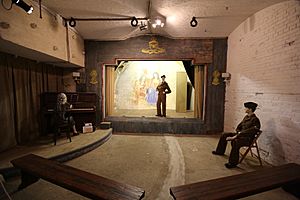
By the First World War, many of Hurst Castle's older guns were outdated. The fort relied on its newer quick-firing weapons. After the war, the guns were removed from the 16th-century part of the castle.
During the Second World War, Hurst was re-armed in 1940 with 12-pounder guns and anti-aircraft guns. A tower, called the Director Tower, was built along the west wing. After the war, most weapons were removed, and the battery closed in July 1945.
In 1956, Hurst Castle became a historic site. When English Heritage was formed in 1983, it took control. Since 1996, the Friends of Hurst Castle have managed the castle day-to-day. The castle is a protected ancient monument. The High Lighthouse from 1867 is still working.
The Hurst Spit is slowly being worn away by the sea, which is a problem for the castle. This erosion has gotten much worse since the 1940s. The government has tried to protect the spit by adding gravel since the 1960s. In February 2021, part of the eastern wing wall collapsed due to this erosion. Repairs started the next month, using shingle and granite to stabilize the wall. English Heritage is still working on full repairs and fundraising to strengthen the sea walls.
Castle Design
The Central Castle
The central part of Hurst Castle was built in the 1500s but was changed a lot in the 1800s. It has a central tower and three bastions (strong points) that are about 52 meters (170 feet) across. A wall with gun positions originally connected the bastions. This wall was later made much thicker with new walls and rooms. The central castle is the main entrance to the fort, through a gate built in 1873. The moat that protected the castle in the 1500s was filled in during the 1860s.
The central tower, or keep, has twelve sides and is about 20 meters (65 feet) across. It has two floors and a basement. Inside, it's round, with a spiral staircase in the middle. The rooms were once living quarters for soldiers but are now open spaces. They have eight windows for lighter weapons. The roof once had gun positions and a lookout tower.
The north-west bastion protected the castle from attacks from the mainland. It had the castle's original portcullis (a heavy gate) and rooms for soldiers. It had three levels of gun positions. This bastion connects to a covered walkway called a caponier, built in 1852, which had rifle loops for defense. The north-east and south-east bastions are one story tall and also had gun positions.
West and East Wings
The West and East Wings were built in the 1860s using brick and stone. They had many gun positions, each designed for a heavy gun and a crew of up to 12 soldiers. These positions were protected by strong granite and iron shields. They also served as living spaces for the crews. Small storage areas for ammunition were behind the gun positions.
The West Wing is about 215 meters (705 feet) long. It has 37 heavy gun positions and two main ammunition stores. It also has other buildings like canteens and detention rooms. Two of the castle's lighthouses are here: an old tower from 1865 and a working iron lighthouse. The garden here is a copy of how it looked during the Second World War. The roof of the West Wing holds positions for quick-firing guns and anti-aircraft guns. A small theatre, built by soldiers during the Second World War, still exists in one of the gun positions, with old wall paintings.
The East Wing is about 150 meters (492 feet) long and has 24 heavy gun positions and two main ammunition stores. The roof has the original gun directing position and an anti-aircraft gun position added during the Second World War. Just beyond the East Wing are three quick-firing gun positions from 1893.
See also
- British narrow gauge military railways




